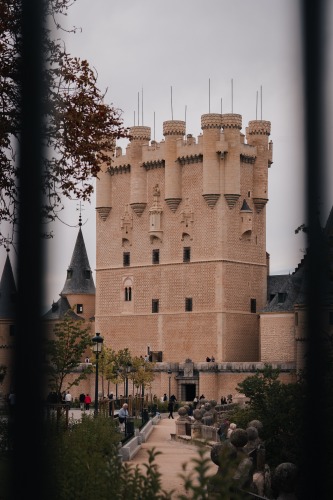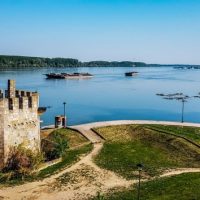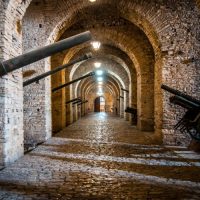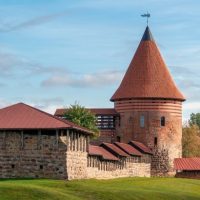Travelers searching for a castle-exploring journey through picturesque countryside need look no further than the country of Spain.
With a rich and storied history of monarchy, which is still being told in modern times, Spain is filled with testaments to wealth and power.
There are over 10,000 castles and palaces throughout the country.
Spain is primarily located on the Iberian Peninsula, with other provinces and territories in the Mediterranean region, as well as the Canary Islands.
Spain’s location as a gatekeeper between the Mediterranean Sea and the Atlantic Ocean has been of particular importance throughout the country’s and region’s history as both a center of commerce and trade as well as a launching point for countless nautical explorations.
Modern-day Spain is the second-largest country in the EU, with a population of roughly 48 million.
Travelers to Spain will have no shortage of modern conveniences and metropolitan amenities, in addition to a treasure trove of historic attractions.
Whatever reason you’re planning to travel to Spain, there are some simple rules to abide by and a few unique customs and traditions to explore while there.
Let’s find out some more about this amazing country.
Contents
1. Alcázar de Segovia
Alcázar de Segovia, located where the Eresma and Clamores Rivers meet, is a 12th-century medieval castle in Segovia.
The castle, which is perched high on a hill overlooking the city, has acted as a stronghold and as the royal residence of Alfonso VIII.
If images of this magical castle look familiar, that’s because it was the inspiration for Walt Disney’s Cinderella castle, along with the Neuschwanstein Castle in Germany.
While first constructed in the 12th century, the fortress was expanded and modified by various rulers over the years.
One of the most prominent features of this fairytale castle is the Torre de Juan.
Also known as the Tower of John II, this rectangular tower is the highest part of the castle.
It’s decorated with twelve exquisite turrets, which offer impressive panoramic views for anyone willing to hike up the 156 steps to the top.
The Sala de Galera boasts expansive windows that offer excellent views of the surrounding valley.
Travelers will also enjoy the gilded Sala de Los Reyes, or throne room, which includes a frieze of the fifty-two kings that ruled the region.
The castle’s turreted towers, conical roofs, halls, and chambers are adorned in the medieval style, including furnishings, tapestries, and weaponry used by the Spanish army.
2. Castillo De Colomares
Just 20 miles south of Malaga lies Castillo De Colomares.
Designed and constructed by Esteban Martín, this castle serves as a monument to Christopher Columbus.
It took seven years and two builders to complete the project, which was finalized in 1994.
While the structure was built in modern times, multiple architectural styles are represented throughout the building, including Gothic, Byzantine, Romanesque, and Mudéjar. Columbus’s travels are narrated throughout the building, offering a glimpse of what he went through to discover America.
It’s easy to get lost in the magnificence of the exterior of Castillo De Colomares.
However, we do recommend visiting the church while on the grounds.
Measuring only 21 feet, this miniature church maintains the Guinness World Record for the Smallest Church in the World.
3. La Alhambra
Overlooking Granada, in the Andalusia region, lies the Alhambra complex.
The castle, which was built in the 13th century, was created in an authentic Andalusian style.
As soon as you step onto the property, you will understand why La Alhambra is a UNESCO World Heritage Site and has influenced everything from literature to music and video games across the globe.
With the snow-topped mountains of the Sierra Nevada as a backdrop, La Alhambra has often been referred to as “a pearl set among emeralds” – the lush trees and vegetation being the emeralds.
The entire compound is surrounded by lavish gardens, with a circular courtyard at its center.
La Alhambra is one of the most visited palaces in Spain.
To ensure access to the compound, it’s recommended that travelers purchase tickets far in advance.
4. Loarre Castle
For a truly magical experience, spend an afternoon at the mystical Loarre Castle.
This castle, which was built to serve as a defense fortress and royal residence, is located in the foothills of the Pyrenees.
It’s perched high on a hill, watching over the mountain town of Ayerbe, and is one of the few Spanish castles whose architecture lacks any Moorish influences.
Originally built in 1020 for King Sancho Ramírez I, Loarre Castle has been restored and added to multiple times over the centuries.
Its most notable additions include the Church of Santa María and a monastery.
Limestone bedrock forms the castle’s foundation and the remains of defensive posts still line the hill leading up to the main building.
5. Castillo de Peñíscola
Midway between Tarragona and Valencia, on the southeastern coast of Spain, lies Castillo de Peñíscola, or Peñíscola Castle.
The Knights Templar constructed Peñíscola Castle over the remains of an old Arab citadel between 1294 and 1307.
Due to its sound construction and location on the rocky edge of a cliff, very few changes have been made to the castle over the centuries.
Castillo de Peñíscola’s most notable features include its carved stone walls, barrel-vaulted rooms, the nave chapel, and the Throne room.
The wonders of this Romanesque castle extend to the exterior as well.
The surrounding grounds are now a botanical park, which features flowers and trees native to the region.
When you’re wandering the gardens, don’t forget to check out the panoramic views of the Costa del Azahar coastline and the Mediterranean Sea.
6. Bellver Castle
Constructed in the early 1300s, Bellver Castle was built by King James of Mallorca.
It served as a royal residence and fortress, protecting the king against several attacks until its fall in the 16th century.
Three Mallorcan kings lived there, including Jaume II, Sanç I, and Jaume III.
Perched on a hill over 350 feet above the Mediterranean, Bellver Castle is surrounded by a moat and rich woods.
While the entire castle is truly majestic, it’s most known for its unique circular design, inspired by the Roman Colosseum.
The fortress also features an interior courtyard, Gothic arcaded patios, and three semicircular buttressed towers.
The north side of the castle boasts a circular tower with a spiral staircase that leads to a terrace and four private rooms.
No stranger to events, the courtyard now hosts cultural events and concerts several times a year.
7. Alcazaba of Málaga
Off the coast of Spain, overlooking the Mediterranean, lies the Alcazaba of Málaga.
Built by the Hammudid dynasty in the 11th century, this citadel is one of the most well-preserved castles in the country.
The castle, which lies on the slopes of the Gibralfaro mountain, is home to multiple historic Arabic, Renaissance, and Roman sites.
A Roman theater rests at the base of the castle and above it is the 8th-century Arab defense.
This portion of the citadel includes multiple battlements and square turrets.
Its interior features orchards, a pool, three main towers, dungeons, and royal chambers.
A secret passageway connects this portion of the fortress to residential chambers that were added in the 11th century.
While you’re in the region, be sure to stop by some of the local museums, including the Centre Pompidou Malaga and the Picasso Museum.
8. Castle of Lorca
Overlooking the Guadalentín Valley in the Murcia region is the 13th-century Castle of Lorca.
Often referred to as Fortaleza del Sol (Fortress of the Sun), the citadel’s two towers overlook the city of Lorca.
These towers are the defining characteristics of the castle. Espolón Tower boasts Mudejar influences.
The Alfonsí Tower, which was restored in the 15th century, is rectangular in shape and boasts a Gothic style.
In addition to the castle’s twin towers, the interior grounds of the castle include a courtyard, a Jewish Quarter with a synagogue, and several archeological exhibits with artifacts dating back over three millennia.
The Castle of Lorca hosts several cultural events throughout the year.
The fortress also offers guided tours, interpretive programs, and children’s workshops.
After a long day of exploring the castle, enjoy a cup of coffee and a meal in the citadel’s courtyard, which features produce sourced from the local region.
9. Palacio Real de Olite
Construction on the Palacio Real de Olite first started in the 12th and 13th centuries.
Built on the grounds of a former Roman citadel, the castle was constructed in two sections – the Palacio Vieja and the Palacio Nuevo.
The New Palace was added in the 15th century.
Built for the Kings of Navarre, who are known for their opulence, Palacio Real de Olite once featured an interior fighting arena, exotic live animals, extravagant decorations, and extensive hanging gardens.
The exterior of Palacio Real de Olite is composed of stone and brick.
Its asymmetrical layout includes keeps, capped towers, and parapets, further adding to the fortress’s charm.
The Spanish government has taken great care in restoring this historical structure so that visitors are able to gain a real understanding of what life was like living there.
Spain Safety Overview
READ THE FULL REPORT: Spain Safety Review
Safety Index:
- OVERALL RISK: MEDIUM
- TRANSPORT & TAXIS RISK: LOW
- PICKPOCKETS RISK: HIGH
- NATURAL DISASTERS RISK: MEDIUM
- MUGGING RISK: LOW
- TERRORISM RISK: MEDIUM
- SCAMS RISK: MEDIUM
- WOMEN TRAVELERS RISK: LOW
Frequently Asked Questions
What Is the Oldest Castle in Spain?
Burgalimar Castle is the oldest castle in Spain and one of the oldest in all of Europe.
Is It Illegal to Build a Sandcastle in Spain?
While building sandcastles is not illegal in every part of Spain, it is in some regions.
Constructing sandcastles in regions like Benidorm, Aron, and Arica in Tenerife could cost you a fine of as much as $150.
When visiting a coastal region, be sure to check the local laws regarding sandcastles.
Is It Safe to Travel Alone in Spain?
Spain is a very safe place to travel and its citizens are friendly and tolerant of tourists from every background.
What Should I Avoid in Spain?
Regional pride is very important to the citizens of Spain.
As a result, it’s best to avoid any conversations about regionalism.
Never call a Catalan Spanish.
Do not walk around a seaside city in your bathing suit; this is actually illegal in some parts of Spain.











